The Mice Galaxies (NGC 4676) are a pair of colliding galaxies located in the constellation Coma Berenices. The two galaxies – designated IC 819 and IC 820 in the Index Catalogue – have apparent magnitudes of 14.7 and 14.4 and lie approximately 290 million light years away. They are known for the long tidal tails of stars and gas produced by their gravitational interaction, which earned them the name the Mice Galaxies.
The Mice Galaxies show a possible future of the Milky Way and Andromeda galaxies when they collide in several billion years. The galaxies are believed to have been almost identical spirals before they started interacting. The similar lengths of their tails indicate that they had similar masses before making contact. Simulations have shown that we are likely seeing the pair about 160 million years after their closest passing.
The galaxy NGC 4676A (IC 819) is about 194,000 light years across and has an apparent size of 2.3 by 0.7 arcminutes. Its neighbour NGC 4676B (IC 820) is slightly smaller, stretching across 186,000 light years and occupying 2.2 by 0.8 arcminutes of the apparent sky. The combined size of the galaxies would be about 380,000 light years, but with the tails it is twice as great, about 760,000 light years across.
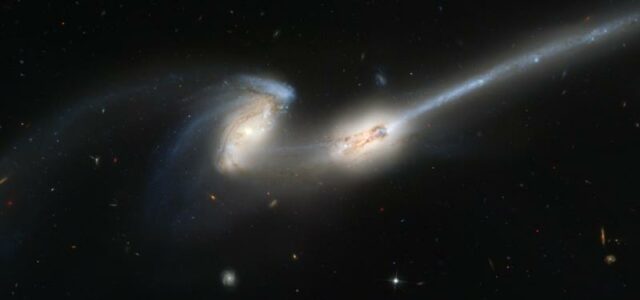
This Hubble Space Telescope image of NGC 4676 shows two spiral galaxies in the process of merging. Their long tidal tails have earned these galaxies the nickname ‘The Mice.’ Image: NASA, H. Ford (JHU), G. Illingworth (UCSC/LO), M.Clampin (STScI), G. Hartig (STScI), the ACS Science Team, and ESA, 2002
The two galaxies have already passed through each other. They are connected by trails of material and will continue to collide over the next billion years until they eventually merge into a single larger elliptical galaxy. The tidal tails are populated by clusters of young, hot blue stars. The stars that are now in the tails, pulled out by strong gravitational tides, will either orbit in the halo of the new galaxy or move to the merged galaxies.
In 2007, a spectroscopic study of young star clusters in NGC 4676 yielded ages of less than 10 million years for 10 clusters and about 170 million years for two clusters in the tidal tails. The age estimates are similar to the dynamical age of the tails and provide the timing of star formation triggered by the interaction of the two galaxies.
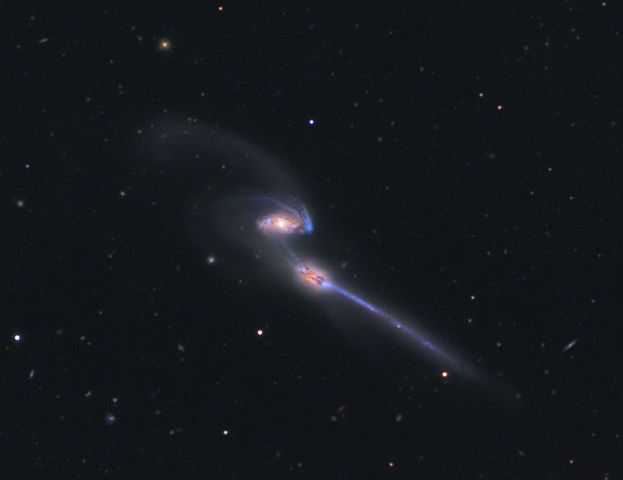
The Mice Galaxies (NGC 4676), image: Adam Block/Mount Lemmon SkyCenter/University of Arizona
Facts
The Mice Galaxies are members of the Coma Cluster of galaxies (Abell 1656). The centre of the cluster lies southeast of the Mice Galaxies and west of the orange giant star 41 Comae Berenices (mag. 4.80) and yellow dwarf Beta Comae Berenices (mag. 4.26), the constellation’s brightest star.
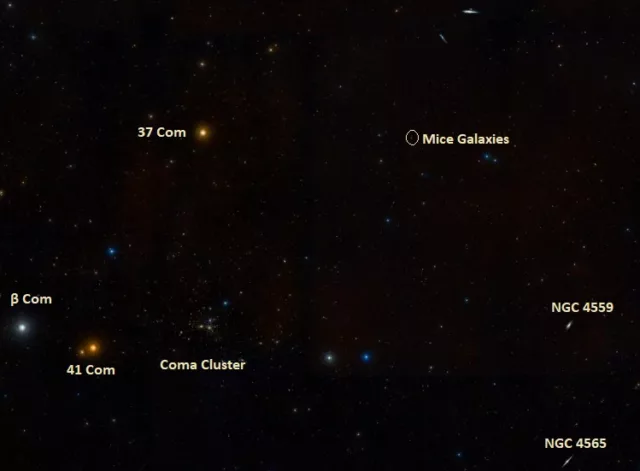
Mice Galaxies and the Coma Cluster, image: Wikisky
The Mice Galaxies lie about four degrees away from the cluster’s centre. They were confirmed to be physical members of the cluster in 1961, when a study showed that they had similar recession velocities to other cluster members.
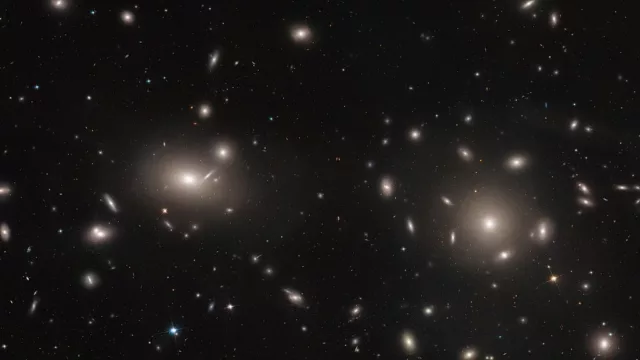
This image, from the NASA/ESA Hubble Space Telescope’s Advanced Camera for Surveys (ACS), reveals thousands of globular clusters lying at the core of a galaxy cluster. It was created by a Hubble survey that drew on data from three of the telescope’s separate observing programmes to explore the centre of the Coma cluster, a huge gathering of over 1000 galaxies, about 320 million light-years away, all bound together by gravity. Astronomers spotted over 22 000 globular clusters, some of which had formed a bridge connecting a pair of well-known interacting galaxies (NGC 4889 and NGC 4874). Image: NASA, ESA, J. Mack, and J. Madrid et al.
The Coma Cluster contains more than a thousand known members. Named after the host constellation, the cluster lies about 321 million light years from Earth and its brightest members have apparent magnitudes of 12 to 14. The central region of the cluster contains mostly elliptical galaxies and is dominated by two giant ellipticals – NGC 4889 (mag. 12.9) and NGC 4874 (mag. 12.7) – which are the cluster’s brightest members. The cluster also contains many lenticular galaxies and fewer spiral galaxies, which are mostly found in the outer regions.
The Hubble Space Telescope photographed the Mice Galaxies using the Advanced Camera for Surveys (ACS) in 2002.
Location
The Mice Galaxies lie in the region of the sky south of Cor Caroli, the brightest star in the constellation Canes Venatici, and northeast of the bright, large Coma Star Cluster (Melotte 111). Cor Caroli is easy to identify because it is the brightest star directly below Alkaid, the star at the tip of the Big Dipper’s handle.
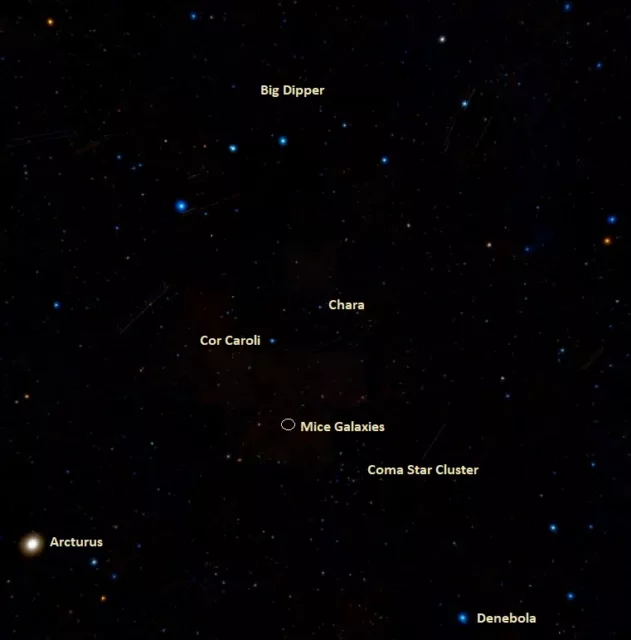
Mice Galaxies location, image: Wikisky
The interacting pair lies in the same area as the Hockey Stick Galaxies (NGC 4565 and NGC 4567) and the Whale Galaxy (NGC 4631). The brighter, larger neighbours lie north of the Mice, in Canes Venatici. They are both members of the NGC 4631 Group.
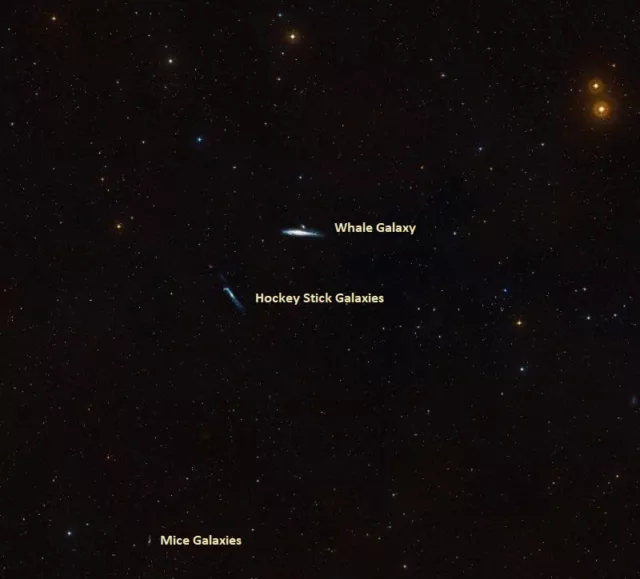
Mice, Whale and Hockey Stick Galaxies, image: Wikisky
There are more than 3,300 galaxies appearing in the background of the Mice Galaxies, located at distances of up to 13 billion years.
The best time of year to observe the Mice and other deep sky objects in Coma Berenices is during the months of spring, when the constellation is prominent in the evening sky.
Mice Galaxies – NGC 4676
| Constellation | Coma Berenices |
| Distance | 290 million light years (89 megaparsecs) |
| Redshift | 6,669 km/s |
| Size | 760,000 light years (233,000 parsecs) |
| Angular size | 2′.3 × 0′.7 |
| Names and designations | Mice Galaxies, NGC 4676, Arp 242, IRAS 12437+3059, VV 224 |
NGC 4676 A (IC 819)
| Type | SABdm or Irr |
| Constellation | Coma Berenices |
| Right ascension | 12h 46m 10.060s |
| Declination | +30° 43′ 54.64” |
| Apparent magnitude | 14.7 |
| Apparent size | 2′.2 × 0′.8 |
| Size | 194,000 light years |
| Redshift | 6613 ± 8 km/s |
| Names and designations | NGC 4676A, IC 819, LEDA 43062, NVSS B124344+310014, SDSS J124610.10+304354.9, SDSS J124610.14+304354.9, UGC 7938, MCG+05-30-076, FIRST J124610.0+304355, 2MASS J12461007+3043548, 2MASX J12461005+3043546 |
NGC 4676B (IC 820)
| Type | SB(s)0/a pec or SBb |
| Constellation | Coma Berenices |
| Right ascension | 12h 46m 11.2492024659s |
| Declination | +30° 43′ 21.853173446” |
| Apparent magnitude | 14.4 |
| Apparent size | 1.70 x 0.88 arcminutes |
| Size | 186,000 light years |
| Redshift | 6607 ± 7 km/s |
| Names and designations | NGC 4676B, IC 820, LEDA 43065, UGC 7939, FIRST J124611.3+304323, MCG+05-30-077, SDSS J124611.24+304321.8, ECO 3706, SDSS J124611.25+304321.9, Gaia DR2 1513265485466088960 |